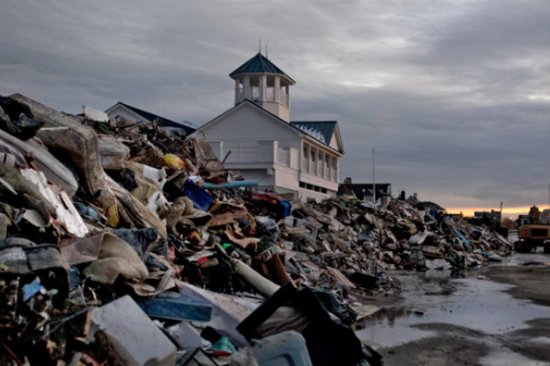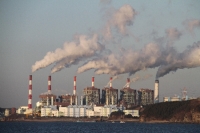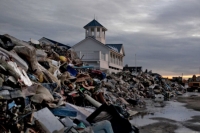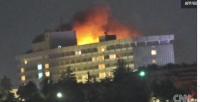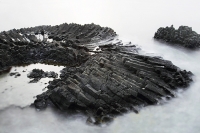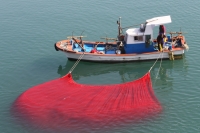(CNN) -- Superstorm Sandy has caused more damage, death and homelessness in New York and New Jersey than any climate-related event in living memory. Yet with two damaging hurricanes two years in a row, and with what science is telling us, this does not feel like a once-in-a-lifetime event. It feels like a trend.
With what we know about rising sea level and what we understand about the rate of world warming and how tropical storms pull their strength from the temperature of the ocean, Sandy feels like a very harshly spoken word to the wise.
And so the answer to the question "What should we do next?" may be difficult, with truly profound implications. I think we really have only two viable long-term building options: 1) Barricade. 2) Retreat.
Carl SafinaRebuilding is not a viable option. And what would we barricade? The whole Long Island to southern New Jersey area? Boston to Washington? The East Coast?
The Netherlands relies on dikes to keep out the sea. There are gates in England to close rivers to storm surges of the kind that last week blew open my friend"s garage door on 22nd Street east of 11th Avenue in New York City, suddenly washing him to the back of his studio, submerging him briefly, floating tons of his art-making tools and ruining decades of drawings and the tools of his trade. Others fared worse, of course.
Become a fan of CNNOpinion
Stay up to date on the latest opinion, analysis and conversations through social media. Join us at Facebook/CNNOpinion and follow us @CNNOpinion on Twitter. We welcome your ideas and comments.
One of my neighbors nearly drowned trying to walk from her home to higher ground half a mile away; two unknown heroes in survival suits wading in waist-high water appeared at the height of the storm and pulled her and her swimming dogs into a canoe and walked them to safety. Her house remains habitable, unlike many others along the coast of Long Island, New York and New Jersey.
By flooding areas that few suspected were within the reach of seawater, Sandy told us that the "coast" is a wider ribbon than we thought it was last week.
So for the hard questions: Should people rebuild? Should the whole country pay for it?
I certainly love shoreside living. I love walking the beach in the morning with my dogs. I love my boat and the people at Montauk"s Westlake Marina where I keep it.
Red Cross under fire over Sandy relief
Sandy leaves Far Rockaway in cold, dark
Disabled mom copes with Sandy aftermath
Volunteers help victims of Sandy I love many facets of the always dynamic water borderlands, the birds and fishes, the turtles and dolphins and other creatures who, in their seasons, draw tight to our coastline. There is magic. And part of that magic is its timelessness. And part of the timelessness is that as the coast changes, the coast is what remains. And yet it moves.
I have federal flood insurance, thank you. But really, it"s time you considered cutting me off.
I am not against people taking their chances along the shore. Risk is part of what draws us. But the risk should be ours to take and bear if we want to.
Federal flood insurance is a counterproductive way for the rest of the country to subsidize people -- putting billions of dollars and millions of lives at continuous risk, encouraging wholly inappropriate development. And it encourages larger, more expensive homes (often second homes) than fewer people would build if their insurance premiums reflected real risk.
In fact, few private insurers will touch most of these places. Let us think twice, fully comprehend that the stakes are ours alone, and then let those of us willing to risk it take our chances.
The government should at this time help victims get their lives back on track. But no federal dollars should magically appear for rebuilding in flood-prone areas. The spots that flood will take repeated hits. Everyone knows this. To help people rebuild in those places is to help put lives and investment in harm"s way. It"s foolish.
Where I live, the houses that stayed dry are the ones just high enough to let water flow around into the extensive, protected wetlands. The houses that flooded stand where water goes on its way to wetlands.
Wetlands are wet for a reason. We would be wise to rebuild in ways that let water flow around dwellings into restored wetlands. Then, two things would start happening:
One: Wetlands, recovered oyster reefs, fish nurseries and wildlife would all be part of a revitalized coastal protection strategy that simultaneously includes recovery of valuable living resources.
Two: The taxpaying public could begin to regain access to the coast for recreation, access too often denied by private development that is largely enabled by taxpayer-funded federal flood insurance.
Eliminating taxpayer-funded flood insurance to people now insured in low, flood-prone areas (including where I live) can be done compassionately, honoring existing insured persons with funding in the aftermath of this wreckage.
But importantly, insurance that would up to now go for rebuilding should be redirected toward relocation and resettlement. That is easier said; for many, relocation would be wrenching. But losing your home or you life can be wrenching, too.
Insurance for new building in flood-prone areas should be ended. People who really want to take their chances should do just that, or pay real commercial insurance premiums if they can find a willing insurer. Eventually even Lloyd"s of London will likely decide it"s had enough. Insurers must be realistic about risk in ways politicians don"t have to be.
Will we choose a wiser course that recognizes that we"re still in the path of the next big storm? I wouldn"t bet on it.
The nonviable option -- to keep rebuilding all the time -- is what people will likely choose. From a decision-making viewpoint, it"s easier to make no decision. But the frequency of big storms appears likely to increase in the Northeast. It"s not a time for easy decisions, because we won"t be faced with easy events.
샌디는 이후 재건하는 것은 너무 큰 위험이
(CNN) - Superstorm 샌디가 더 손상, 죽음과 메모리를 생활에서 기후 관련 이벤트보다 뉴욕과 뉴저지의 무주택을 일으킬 수있다. 이년 연속 두 피해 허리케인, 과학은 우리에게 말해주고있는 걸과 함께하지만,이 평생에 한 번 이벤트처럼 보이지는 않는다. 이 추세 인 것 같아요.
우리가 상승 바다 수준과 우리가 세계 온난화의 속도와 방법에 열대 폭풍우가 바다의 온도에서 힘을 끌어 이해에 대해 알고있는으로, 샌디 현명한 매우하겠다고 말한 단어 인 것 같아요.
그리고 질문에 대한 답변은 "우리가 다음 무엇을해야합니까?" 진정한 깊은 의미와 함께, 어려울 수 있습니다. 1) 바리케이드 : 난 우리가 정말 두 가능한 장기 건물 옵션을 사용할 수 있습니다 생각합니다. 2) 후퇴 다.
칼의 SafinaRebuilding는 실행 가능한 옵션이 없습니다. 그리고 우리는 무엇을 막으까요? 남부 뉴저지 지역 전체 롱 아일랜드? 워싱턴 보스턴? 동부 해안?
네덜란드는 바다를 유지하기 dikes에 의존하고 있습니다. 폭풍에 강을 닫는 영국의 문 지난 주에 갑자기 떠, 잠시 그를 잠수, 그의 스튜디오의 뒷면에 그 세탁기, 뉴욕시 (New York City)에 11 번가의 22번째 거리 동쪽에서 내 친구의 차고 문을 열어 버렸 가지 서지가 있습니다 그의 예술 제작 도구 및 도면과 무역의 도구 망치고 년간의 톤. 기타 물론, 더 못했다.
CNNOpinion의 팬되기
소셜 미디어를 통해 최신 의견, 분석 및 대화에 대한 최신 정보를 받아. 페이스 북 / CNNOpinion에서 우리와 함께하고 트위터에서 우리 @ CNNOpinion를 따르십시오. 우리는 여러분의 아이디어와 의견을 환영합니다.
내 이웃 중 하나는 거의 반 마일 거리에 높은지면에 그녀의 집에서 도보하려고 익사, 허리 높이의 물에 조사 생존 소송에서 두 알 수없는 영웅이 폭풍의 높이에 나타나 카누에 그녀와 그녀의 수영 개를 당 겼고, 안전으로 걸어 갔다. 그녀의 집은 롱 아일랜드, 뉴욕, 뉴저지 해안을 따라 많은 사람들과는 달리 거주 남아 있습니다.
의심 몇몇 해수의 이동 거리에 있다는 지역 홍수로, 샌디는 "해안는"우리가 지난 주에 생각보다 넓은 리본이 우리에게 말했다.
따라서 하드 질문 : 사람들은 재건해야 하는가? 나라 전체가 그 비용을 지불해야하나요?
난 분명히 shoreside의 생활을 사랑 해요. 내 강아지와 함께 아침에 해변을 산책 사랑 해요. 내가 그렇게 할 곳 Montauk의 웨스트 레이크 마리나에서 내 보트 사람들을 사랑 해요.
샌디는 구호 이상 불 이하 적십자
샌디는 추위, 어둠 속에서 좀 떨어진 로커 웨이 떠난다
샌디 여파로 비활성화 엄마 copes
자원 봉사자는 내가 자신의 계절에 우리의 해안에 꼭 끌어, 많은 항상 동적 물 borderlands의면, 새와 물고기, 거북이, 돌고래 등의 동물을 사랑 샌디의 피해자를 할 수 있습니다. 마법이 있습니다. 그리고 그 마법의 부분은 timelessness입니다. 그리고 timelessness의 일부는 해안 변경 등의 해안이 남아 있기 때문입니다. 그리고 아직 움직입니다.
난 연방 홍수 보험이, 감사합니다. 하지만 정말, 당신이 날을 잘라내는 고려 때입니다.
나는 해안을 따라 자신의 위험을 무릅 명에 대해 아닙니다. 위험 우리를 이끌 었는지의 일부입니다. 그러나 위험은 가지고 우리가 원하는 경우 부담 우리들해야합니다.
전적으로 부적절한 개발을 장려, 지속적인 위험에 삶의 달러 수백만 수십억를 넣어 - 연방 홍수 보험은 사람들을 보조 할 수있는 국가의 나머지에 대한 역효과를 방법입니다. 그리고 자신의 보험료가 진짜 위험을 반영하는 경우 적은 사람들이 만드는 것보다 더 크고 비싼 주택을 (보통 두번째 집) 권장합니다.
사실, 몇 개인 보험이 곳의 대부분을 터치합니다. 우리는 두 번, 완전히 말뚝 혼자 우리 것을 이해하고, 그 우리의 가능성을 감수 할 의향이 우리 사람들을하게 생각해 보자.
정부는 현재 도움말 피해자는 제 궤도에 다시 자신의 삶을해야합니다. 그러나 연방 달러가 마술 홍수 발생하기 쉬운 지역에서 재건에 게재 없습니다. 홍수가 반복적으로 충격을 견딜 것을 명소. 모든 사람이 알고 있습니다. 사람들이 그 장소에 세우는 데 도움이하는 것은 PUT 삶과 위험의 방법으로 투자를하는 것입니다. 건 바보 같은 짓이다.
내가 살고있는 곳, 드라이 머물 집은 광범위하고 보호 습지로 주변에 물이 흘러 가게 할 나이가 높은 사람들입니다. 물이 습지로의 길에가는 거기 서서 침수 가옥.
습지 이유가 젖었. 우리는 복원 습지에 주거 주위에 물 흐름을 알려 방법으로 재건하는 것이 현명 것입니다. 그런 다음 두 가지 일이 일어나고 시작합니다 :
하나 : 습지, 복구 굴 산호초, 물고기 보육원과 야생 동물 모두가 동시에 가치있는 생활 자원의 복구를 포함하는 활성화 해안 보호 전략의 일부가 될 것입니다.
두 : taxpaying 대중이 대부분 납세자 투자 연방 홍수 보험에 의해 활성화되어 너무 자주 개인 개발에 의해 거부 레크리에이션, 액세스 해안에 대한 액세스 권한을 다시 시작 수 있습니다.
지금 저, 홍수 발생하기 쉬운 지역 (내가 사는 곳 포함)에 보험 사람들에게 세금 투자 홍수 보험을 제거하면이 비행기 잔해의 여파에 자금과 기존의 피보험자의 자만심, 납치 사건 수행 할 수 있습니다.
그러나 중요한 것은, 최대 지금 재건가는 것입니다 보험은 이주 및 정착으로 이동해야합니다. 그 말 쉽게, 많은 사람을 위해, 재배치는 중력 것입니다. 그러나 당신의 집이나 생활을 잃는 것은 역시 중력 될 수 있습니다.
홍수 발생하기 쉬운 지역에 새로운 건물을위한 보험은 종료해야합니다. 정말 자신의 위험을 감수하려는 사람은 그냥, 또는 사람들이 기꺼이 보험사를 찾을 수 있는지 실제 상용 보험료를 지불해야한다. 결국도 로이드의 런던 (London)의 가능성이 그만큼을 받았어요 결정합니다. 보험사는 정치인이 될 필요가 없습니다 방식으로 위험에 대한 현실적인해야합니다.
우리는 다음 큰 폭풍의 경로에 계속 있다고 인식 현명한 코스를 선택하나요? 장담 않습니다.
nonviable 옵션 - 모든 시간을 재건 유지하기는 - 사람들이 가능성이 선택 될지입니다. 의사 결정 관점에서, 아무 결정을 만들어주기 쉬워졌습니다. 그러나 큰 폭풍의 주파수는 동북에서 증가 할 것으로 예상 나타납니다. 우리가 쉽게 이벤트에 직면하지 않습니다 때문에 쉽게 결정을위한 시간이 없습니다.
